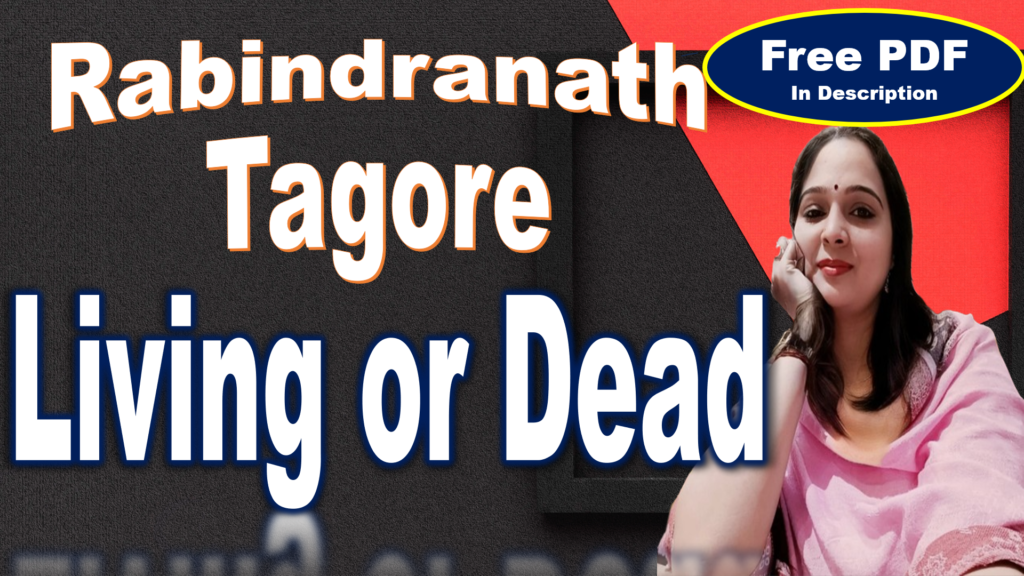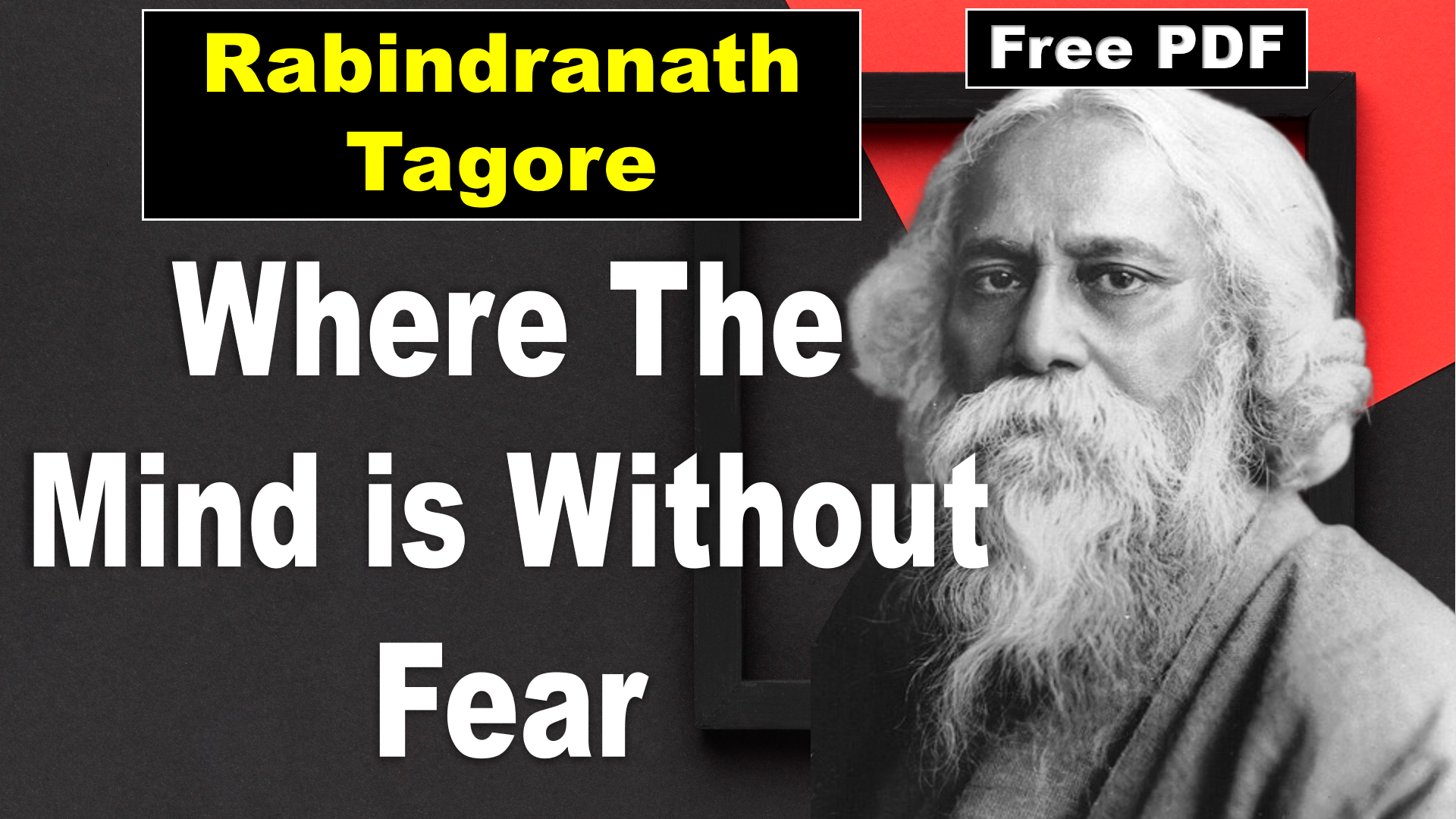
Living or Dead by Rabindranath Tagore | Jibito o Mrito | Summary | Plot | Rabindranath Tagore | Characters | Themes | Symbolism | Questions Answers | Free PDF Download – Easy Literary Lessons
Living or Dead
“Jibita o Mrita” (Living or Dead) is a Bengali-language short story written by Rabindranath Tagore in 1892.
The story revolves around Kadambini, a widow with no child. She has a great bond with her brother-in-law’s son. One night, suddenly she dies. The four Brahmins take her for ritual cremation. But she regains her life back and walks out. She does not go to her home as she thinks herself a ghost. With the help of a man, she comes to her friend Jogamaya’s home. But she leads an uneasy life and so she has to leave the company of Jogamaya. She returns at her own in-laws home. But the family members do not take her as a living being. At last, after committing suicide, she proved that she was alive.
The story combines the two unique forms of literature: the supernatural tale and the ironic parable. But it is not a perfect supernatural story. The existence of Kadambini is supernatural. It depicts the idea of being stuck between life and death. In short, it deals with the mystery of death. The punch line of the story is “Kadambini moriya praman korilo, she more nai” (By dying, Kadambini proved that she did not die).
Plot
1
The widow in the house of Saradasankar, the Ranihat zemindar, had no kinsmen of her father’s family. One after another all had died. Nor had she in her husband’s family any one she could call her own, neither husband nor son. The child of her brother-in-law Saradasankar was her darling. Far a long time after his birth, his mother had been very ill, and the widow, his aunt Kadambini, had fostered him. If a woman fosters another’s child, her love for him is all the stronger because she has no claim upon him-no claim of kinship, that is, but simply the claim of love. Love cannot prove its claim by any document which society accepts, and does not wish to prove it; it merely worships with double passion its life’s uncertain treasure. Thus all the widow’s thwarted love went out to wards this little child. One night in Sraban Kadambini died suddenly. For some reason her heart stopped beating. Everywhere else the world held on its course; only m this gentle little breast, suffering with love, the watch of time stood still for ever.
Lest they should be harassed by the poike, four of the zemindar’s Brahmin servants took away the body, without ceremony, to be burned. The burning-ground of Ranihat was very far from the village. There was a hut beside a tank, a huge banian near it, and nothing more. Formerly a river, now completely dried up, ran through the ground, and part of the watercourse had been dug out to make a tank for the performance of funeral rites. The people considered the tank as part of the river and reverenced it as such.
Taking the body into the hut, the four men sat down to wait for the wood. The time seemed so long that two of the four grew restless, and went to see why it did not come. Nitai and Gurucharan being gone, Bidhu and Banamali remained to watch over the body.
It was a dark night of Sraban. Heavy clouds hung In a starless sky. The two men sat silent in the dark room. Their matches and lamp were useless. The matches were damp, and would not light, for all their efforts, and the lantern went out.
After a long silence, one said: “Brother, it would be good if we had a bowl of tobacco. In our hurry we brought none.”
The other answered: “I can run and bring all we want.”
Understanding why Banamali wanted to go (From fear of ghosts, the burning-ground being considered haunted.), Bidhu said: “I daresay! Meanwhile, I suppose I am to sit here alone!”
Conversation ceased again. Five minutes seemed like an hour. In their minds they cursed the two, who had gone to fetch the wood, and they began to suspect that they sat gossiping in some pleasant nook. There was no sound anywhere, except the incessant noise of frogs and crickets from the tank. Then suddenly they fancied that the bed shook slightly, as if the dead body had turned on its side. Bidhu and Banamali trembled, and began muttering: “Ram, Ram.” A deep sigh was heard in the room. In a moment the watchers leapt out of the hut, and raced for the village.
After running aboat three miles, they met their colleagues coming back with a lantern. As a matter of fact, they had gone to smoke, and knew nothing about the wood. But they declared that a tree had been cut down, and that, when it was split up, it would be brought along at once. Then Bidhu and Banamali told them what had happened in the hut. Nitai and Gurucharan scoffed at the story, and abused Bidhu and Banamali angrily for leaving their duty.
Without delay all four returned to the hut. As they entered, they saw at once that the body was gone; nothing but an empty bed remained. They stared at one another. Could a jackal have taken it? But there was no scrap of clothing anywhere. Going outside, they saw that on the mud that had collected at the door of the but there were a woman’s tiny footprints, newly made. Saradasankar was no fool, and they could hardly persuade him to believe in this ghost story. So after much discussion the four decided that it would be best to say that the body had been burnt.
Towards dawn, when the men with the wood arrived they were told that, owing to their delay, the work had been done without them; there had been some wood in the but after all. No one was likely to question this, since a dead body is not such a valuable property that any one would steal it.
2
Everyone knows that, even when there is no sign, life is often secretly present, and may begin again in an apparently dead body. Kadambini was not dead; only the machine of her life had for some reason suddenly stopped.
When consciousness returned, she saw dense darkness on all sides. It occurred to her that she was not lying in her usual place. She called out ” Sister,” but no answer came from the darkness. As she sat up, terror-stricken, she remembered her death-bed, the sudden pain at her breast, the beginning of a choking sensation. Her elder sister-in-law was warming some milk for the child, when Kadambini became faint, and fell on the bed, saying with a choking voice: “Sister, bring the child here. I am worried.” After that everything was black, as when an inkpot is upset over an exercise-book. Kadambini’s memory and consciousness, all the letters of the world’s book, in a moment became formless. The widow could not remember whether the child, in the sweet voice of love, called her ” Auntie,” as if for the last time, or not; she could not remember whether, as she left the world she knew for death’s endless unknown journey, she had received a parting gift of affection, love’s passage-money for the silent land. At first, I fancy, she thought the lonely dark place was the House of Yama, where there is nothing to see, nothing to hear, nothing to do, only an eternal watch. But when a cold damp wind drove through the open door, and she heard the croaking of frogs, she remembered vividly and in a moment all the rains of her short life, and could feel her kinship with the earth. Then came a flash of lightning, and she saw the tank, the banian, the great plain, the far-off trees. She remembered how at full moon she had sometimes come to bathe in this tank, and how dreadful death had seemed when she saw a corpse on the burning-ground.
Her first thought was to return home. But then she reflected: “I am dead. How can I return home? That would bring disaster on them. I have left the kingdom of the living; I am my own ghost!” If this were not so, she reasoned, how could she have got out of Saradasankar’s well-guarded zenana, and come to this distant burningground at midnight? Also, if her funeral rites had not been finished, where had the men gone who should burn her? Recalling her death-moment in Saradasankar’s brightly-lit house, she now found herself alone in a distant, deserted, dark burning. ground. Surely she was no member of earthly society! Surely she was a creature of horror, of ill-omen, her own ghost!
At this thought, all the bonds were snapped which bound her to the world. She felt that she had marvellous strength, endless freedom. She could do what she liked, go where she pleased. Mad with the inspiration of this new idea, she rushed from the but like a gust of wind, and stood upon the burning. ground. All trace of shame or fear had left her. But as she walked on and on, her feet grew tired, her body weak. The plain stretched on endlessly; here and there were paddy-fields; sometimes she found herself standing knee-deep in water.
At the first glimmer of dawn she heard one or two birds cry from the bamboo-clumps 6y the distant houses. Then terror seized her. She could not tell in what new relation she stood to the earth and to living folk. So long as she had been on the plain, on the burning-ground, covered by the dark night of Sraban, so long she had been fearless, a denizen of her own kingdom. By daylight the homes of men filled her with fear. Men and ghosts dread each other, for their tribes inhabit different banks of the river of death.
3
Her clothes were clotted in the mud; strange thoughts and walking by night had given her the aspect of a madwoman; truly, her apparition was such that folk might have been afraid of her, and children might have stoned her or run away. Luckily, the first to catch sight of her was a traveller. He came up, and said: “Mother, you look a respectable woman. Wherever are you going, alone and in this guise?”
Kadambini, unable to collect her thoughts, stared at him in silence. She could not think that she was still in touch with the world, that she looked like a respectable woman, that a traveller was asking her questions.
Again the min said: “Come, mother, I will see you home. Tell me where you live.”
Kadambini thought. To return to her father-in-law’s house would be absurd, and she had no father’s house. Then she remembered the friend of her childhood. She had not seen Jogmaya since the days of her youth, but from time to time they had exchanged letters. Occasionally there had been quarrels between them, as was only right, since Kadambini wished to make it dear that her love for Jogmaya was unbounded, while her friend complained that Kadambini did not return a love equal to her own. They were both sure that, if they once met, they would be inseparable.
Kadambini said to the traveller: “I will go to Sripati’s house at Nisindapur.”
As he was going to Calcutta, Nisindapur, though not near, was on his way. So he took Kadambini to Sripati s house, and the friends met again. At first they did not recognise one another, but gradually each recognised the features of the other’s childhood.
“What luck!” said Jogmaya. “I never dreamt that I should see you again. But how hate you come here, sister? Your father-in-law’s folk surely didn’t let you go!”
Kadambini remained silent, and at last said: “Sister, do not ask about my father-in-law. Give me a corner, and treat me as a servant: I will do your work.”
“What?” cried Jogmaya. “Keep you like a servant! Why, you are my closest friend, you are my –” and so on and so on.
Just then Sripati came in. Kadambini stared at him for some time, and then went out very slowly. She kept her head uncovered, and showed not the slightest modesty or respect. Jogmaya, fearing that Sripati would be prejudiced against her friend, began an elaborate explanation. But Sripati, who readily agreed to anything Jogmaya said, cut short her story, and left his wife uneasy in her mind.
Kadambini had come, but she was not at one with her friend: death was between them. She could feel no intimacy for others so long as her existence perplexed her and consciousness remained. Kadambini would look at Jogmaya, and brood. She would think: ” She has her husband and her work, she lives in a world far away from mine. She shares affection and duty with the people of the world; I am an empty shadow. She is among the living; I am in eternity.”
Jogmaya also was uneasy, but could not explain why. Women do not love mystery, because, though uncertainty may be transmuted into poetry, into heroism, into scholarship, it cannot be turned to account in household work. So, when a woman cannot understand a thing, she either destroys and forgets it, or she shapes it anew for her own use; if she fails to deal with it in one of these ways, she loses her temper with it. The greater Kadambini’s abstraction became, the more impatient was Jogmaya with her, wondering what trouble weighed upon her mind. Then a new danger arose. Kadambini was afraid of herself; yet she could not flee from herself. Those who fear ghosts fear those who are behind them; wherever they cannot see there is fear. But Kadambini’s chief terror lay in herself, for she dreaded nothing external. At the dead of night, when alone in her room, she screamed; in the evening, when she saw her shadow in the lamp-light, her whole body shook. Watching her fearfulness, the rest of the house fell into a sort of terror. The servants and Jogmaya herself began to see ghosts.
One midnight, Kadambini came out from her bedroom weeping, and wailed at Jogmaya’s door: “Sister, sister, let me lie at your feet! Do not put me by myself!”
Jogmaya’s anger was no less than her fear. She would have liked to drive Kadambini from the house that very second. The good-natured Sripati, after much effort, succeeded in quieting their guest, and put her in the next room.
Next day Sripati was unexpectedly summoned to his wife’s apartments. She began to upbraid him: ” You, do you call yourself a man? A woman runs away from her father-in-law, and enters your house; a month passes, and you haven’t hinted that she should go away, nor have I heard the slightest protest from you. I should cake it as a favour if you would explain yourself. You men are all alike.”
Men, as a race, have a natural partiality for womankind in general, foe which women themselves hold them accountable. Although Sripati was prepared to touch Jogmaya’s body, and swear that his kind feeling towards the helpless but beautiful Kadambini was no whit greater than it should be, he could not prove it by his behaviour. He thought that her father-in-law’s people must have treated this forlorn widow abominably, if she could bear it no longer, and was driven to take refuge with him. As she had neither father nor mother, how could he desert her? So saying, he let the matter drop, far he had no mind to distress Kadambini by asking her unpleasant questions.
His wife, then, tried other means of her sluggish lord, until at last he saw that for the sake of peace he must send word to Kadambini’s father-in-law. The result of a letter, he thought, might not be satisfactory; so he resolved to go to Ranihat, and act on what he learnt.
So Sripati went, and Jogmaya on her part said to Kadambini “Friend, it hardly seems proper for you to stop here any longer. What will people say? “
Kadambini stared solemnly at Jogmaya, and said: “What have I to do with people?”
Jogmaya was astounded. Then she said sharply: “If you have nothing to do with people, we have. How can we explain the detention of a woman belonging to another house?”
Kadambini said: “Where is my father-in-law’s house?”
“Confound it!” thought Jogmaya. “What will the wretched woman say next?”
Very slowly Kadambini said: “What have I to do with you? Am I of the earth? You laugh, weep, love; each grips and holds his own; I merely look. You are human, I a shadow. I cannot understand why God has kept me in this world of yours.”
So strange were her look and speech that Jogmaya understood something of her drift, though not all. Unable either to dismiss her, or to ask her any more questions, she went away, oppressed with thought.
4
It was nearly ten o’clock at night when Sripati returned from Ranihat. The earth was drowned in torrents of rain. It seemed that the downpour would never stop, that the night would never end.
Jogmaya asked: “Well?”
“I’ve lots to say, presently.”
So saying, Sripati changed his clothes, and sat down to supper; then he lay dawn for a smoke. His mind was perplexed.
His wife stilled her curiosity for a long time; then she came to his couch and demanded: “What did you hear?”
“That you have certainly made a mistake.”
Jogmaya was nettled. Women never make mistakes, or, if they do, a sensible man never mentions them; it is better to take them on his own shoulders. Jogmaya snapped: “May I be permitted to hear how?”
Sripati replied: “The woman you have taken into your house is not your Kadambini.”
Hearing this, she was greatly annoyed, especially since it was her husband who said it. “What! I don’t know my own friend? I must come to you to recognise her! You are clever, indeed!”
Sripati explained that there was no need to quarrel about his cleverness. He could prove what he said. There was no doubt that Jogmaya’s Kadambini was dead.
Jogmaya replied: “Listen! You’ve certainly made some huge mistake. You’ve been to the wrong house, or are confused as to what you have heard. Who told you to go yourself? Write a letter, and everything will be cleared up.”
Sripati was hurt by his wife’s lack of faith in his executive ability; he produced all sorts of proof, without result. Midnight found them still asserting and contradicting. Although they were both agreed now that Kadambini should be got out of the house, although Sripati believed that their guest had deceived his wife all the time by a pretended acquaintance, and Jogmaya that she was a prostitute, yet in the present discussion neither would acknowledge defeat. By degrees their voices became so loud that they forgot that Kadambini was sleeping in the next room.
The one said: “We’re in a nice fix! I tell you, I heard it with my own ears!” And the other answered angrily: “What do I care about that? I can see with my own eyes, surely.”
At length Jogmaya said: “Very well. Tell me when Kadambini died.” She thought that if she could find a discrepancy between the day of death and the date of some letter from Kadambini, she could prove that Sripati erred.
He told her the date of Kadambini’s death, and they both saw that it fell on the very day before she came to their house. Jogmaya’s heart trembled, even Sripati was not unmoved.
Just then the door flew open; a damp wind swept in and blew the lamp out. The darkness rushed after it, and filled the whole house. Kadambini stood in the room. It was nearly one o’clock, the rain was pelting outside.
Kadambini spoke: “Friend, I am your Kadambini, but I am no longer living. I am dead.”
Jogmaya screamed with terror; Sripati could speak.
“But, save in being dead, I have done you no wrong. If I have no place among the living, I have none among the dead. Oh! whither shall I go?”
Crying as if to wake the sleeping Creator in the dense night of rain, she asked again: ” Oh! whither shall I go? “
So saying Kadambini left her friend fainting in the dark house, and went out into the world, seeking her own place.
5
It is hard to say how Kadambini reached Ranihat. At first she showed herself to no one, but spent the whole day in a ruined temple, starving. When the untimely afternoon of the rains was pitch-black, and people huddled into their houses for fear of the impending storm, then Kadambini came forth. Her heart trembled as she reached her father-in- law’s house; and when, drawing a thick veil over her face, she entered, none of the doorkeepers objected, since they took her for a servant. And the rain was pouring down, and the wind howled.
The mistress, Saradasankar’s wife, was playing cards with her widowed sister. A servant was in the kitchen, the sick child was sleeping in the bedroom. Kadambini, escaping every one’s notice, entered this room. I do not know why she had come to her father-in-law’s house; she herself did not know; she felt only that she wanted to see her child again. She had no thought where to go next, or what to do.
In the lighted room she saw the child sleeping, his fists clenched, his body wasted with fever. At sight of him, her heart became parched and thirsty. If only she could press that tortured body to her breast! Immediately the thought followed: “I do not exist. Who would see it? His mother loves company, loves gossip and cards. All the time that she left me in charge, she was herself free from anxiety, nor was she troubled about him in the least. Who will look after him now as I did?”
The child turned on his side, and cried, half-asleep: “Auntie, give me water.” Her darling had not yet forgotten his auntie! In a fever of excitement, she poured out some water, and, taking him to her breast, she gave it him.
As long as he was asleep, the child felt no strangeness in taking water from the accustomed hand. But when Kadambini satisfied her long-starved longing, and kissed him and began rocking him asleep again, he awoke and embraced her. “Did you die, Auntie?” he asked.
“Yes, darling.”
“And you have come back? Do not die again.”
Before she could answer disaster overtook her. One of the maidservants coming in with a cup of sago dropped it, and fell down. At the crash the mistress left her cards, and entered the room. She stood like a pillar of wood, unable to flee or speak. Seeing all this, the child, too, became terrified, and burst out weeping: ” Go away, Auntie,” he said, “go away!”
Now at last Kadambini understood that she had not died. The old room, the old things, the same child, the same love, all returned to their living state, without change or difference between her and them. In her friend’s house she had felt that her childhood’s companion was dead. In her child’s room she knew that the boy’s “Auntie” was not dead at all. In anguished tones she said: “Sister, why do you dread me? See, I am as you knew me.”
Her sister-in-law could endure no longer, and fell into a faint. Saradasankar himself entered the zenana. With folded hands, he said piteously: “Is this right? Satis is my only son. Why do you show yourself to him? Are we not your own kin? Since you went, he has wasted away daily; his fever has been incessant; day and night he cries: `Auntie, Auntie.’ You have left the world; break these bonds of maya (Illusory affection binding a soul to the world). We will perform all funeral honours.”
Kadambini could bear no more. She said: “Oh, I am not dead, I am not dead. Oh, how can I persuade you that I am not dead? I am living, living!” She lifted a brass pot from the ground and dashed it against her forehead. The blood ran from her brow. “Look!” she cried, “I am living!” Saradasankar stood like an image; the child screamed with fear, the two fainting women lay still.
Then Kadambini, shouting “I am not dead, I am not dead,” went down the steps to the zenana well, and plunged in. From the upper storey Saradasankar heard the splash.
All night the rain poured; it poured next day at dawn, was pouring still at noon. By dying, Kadambini had given proof that she was not dead.





